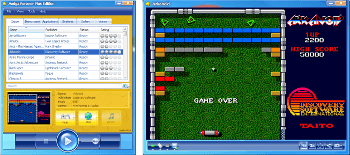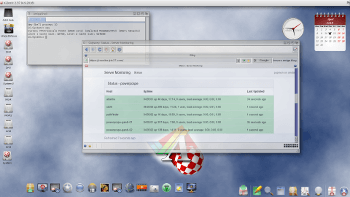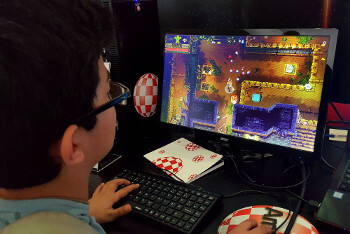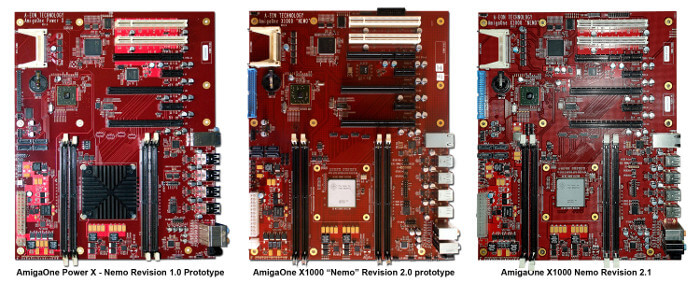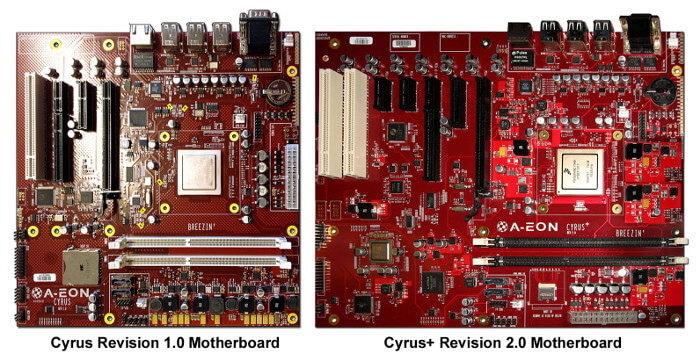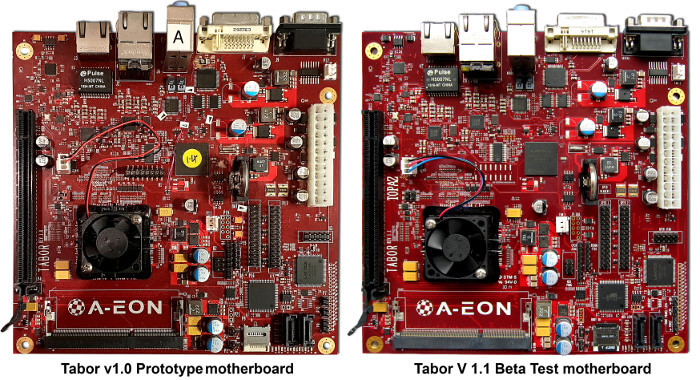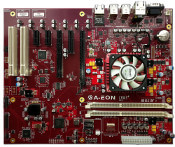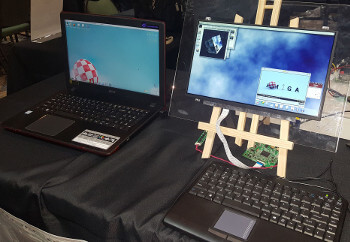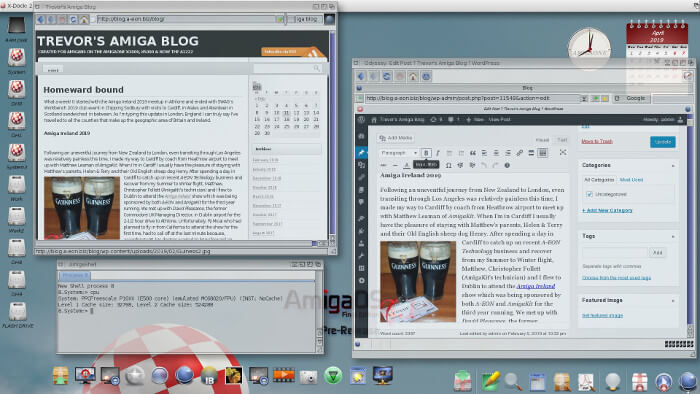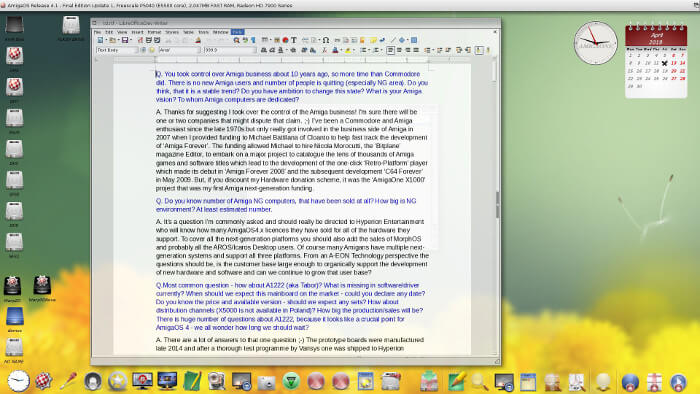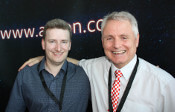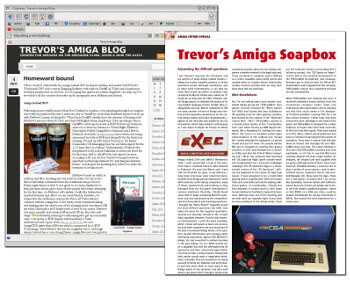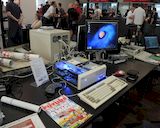eXec: You took control over Amiga business about 10 years ago, so more time than Commodore did. There is no new Amiga users and number of people is quitting (especially NG area). Do you think, that it is a stable trend? Do you have ambition to change this state? What is your Amiga vision? To whom Amiga computers are dedicated?
Trevor Diskinson: Thanks for suggesting I took over the control of the Amiga business! I'm sure there will be one or two companies that might dispute that claim. ;-) I've been a Commodore and Amiga enthusiast since the late 1970s but only really got involved in the business side of Amiga in 2007 when I provided funding to Michael Battilana of Cloanto to help fast track the development of 'Amiga Forever'.
The funding allowed Michael to hire Nicola Morocutti, the 'Bitplane' magazine Editor, to embark on a major project to catalogue the tens of thousands of Amiga games and software titles which lead to the development of the one-click 'Retro-Platform' player which made its debut in 'Amiga Forever 2008' and the subsequent development 'C64 Forever' in May 2009. But, if you discount my Hardware donation scheme, it was the 'AmigaOne X1000' project that was my first Amiga next-generation funding.
eXec: Do you know number of Amiga NG computers, that have been sold at all? How big is NG environment? At least estimated number.
TD: It's a question I'm commonly asked and should really be directed to Hyperion Entertainment who will know how many AmigaOS4.x licences they have sold for all of the hardware they support. To cover all the next-generation platforms you should also add the sales of MorphOS and probably all the AROS/Icaros Desktop users. Of course many Amigans have multiple next-generation systems and support all three platforms. From an A-EON Technology perspective the questions should be, is the customer base large enough to organically support the development of new hardware and software and can we continue to grow that user base?
eXec: Most common question - how about A1222 (aka Tabor)? What is missing in software/driver currently? When should we expect this mainboard on the market - could you declare any date? Do you know the price and available version - should we expect any sets? How about distribution channels (X5000 is not available in Poland)? How big the production/sales will be? There is huge number of questions about A1222, because it looks like a crucial point for AmigaOS 4 - we all wonder how long we should wait?
TD: There are a lot of answers to that one question ;-) The prototype boards were manufactured late 2014 and after a thorough test programme by Varisys one was shipped to Hyperion Entertainment to enable porting of ExecSG to begin.
Knowing that AmigaOS4 developers still had their hands full with the AmigaOne X5000 port we also shipped a handful of boards to A-EON's core Linux support team so they could test all the on-board components under Linux. In the mainstream computer world, hardware manufacturers, like Freescale, use Linux when developing new chips to create board-support and system-support packages that can be freely shared with partners early in the development cycle to test and promote support for their new products. We commissioned Varisys, our hardware partner, to create a rudimentary Linux port for the Tabor motherboard so we could test all the onboard components were working as expected.
Our Linux team quickly got to work and over the next few months created working ports of Debian and SliTaz ports to check out all on board components including Ethernet and audio. The development of the AmigaOS 4.x port was delayed due to a number of well documented external factors. Finally in January 2017 Hyperion released the first alpha AmigaOS 4.x iso for the Tabor motherboard which transformed it from a PowerPC computer running Linux to an AmigaOne A1222 and so the beta test of AmigaOS 4.x began in earnest. Meanwhile, the Tabor hardware has been thoroughly tested by our Core Linux team and various Debian PowerPC distributions have been running on the Tabor motherboard for several years as well as PowerPC versions of Ubuntu and Lubuntu. Two Tabor boards were shipped to John Paul Adrian Glaubitz, an official Debian maintainer in Germany, who has been running the boards 24/7 for the past couple of years helping to auto-build the special Debian powerpcspe packages. You can check out Atlantis and Pathfinder here.
So what AmigaOS 4 components still need to be worked on? The Audio driver, which works fine under Linux, is still under development and the SATA driver which is functional needs a little polishing. The special FPU optimisation 'trampoline' code created by Thomas Frieden is also functional but needs a little more work and a couple of core OS4 components are being optimised to take advantage of the more efficient SPE code.
As Daniel Mussener reported when he used SPE code to speed up his Tower57 port, "if you check out the fps counter you'll notice that it runs pretty fast, actually quite a lot faster than on a sam460ex". He later posted, "The "normal" Tower57 FPU build works too on the Tabor btw. In that case, as with all other FPU-using programs, the OS' current compatibility backend kicks in (Thomas' unique 'trampoline' code) and "translates" each and every FPU-opcode into something the Tabor likes. Interesting enough: even then the Tabor is so powerful that it's still playable (about 20fps where the sam460 reaches about 30fps)."
The good news is the A1222 fully supports all of A-EON's latest graphics drivers including Warp3D Nova and the latest Enhancer Software pack which adds a whole host of new features and utilities. We pre-paid for 1,000 P1022 CPUs (see also my answer below) in preparation for the first commercial production of motherboards which we anticipated would take place in late 2015/early 2016. Best laid plans of mice and men etc...
So when will the AmigaOne A1222 actually start shipping? We have all the CPUs in-hand but since the prototypes were produced in late 2014 a couple of on-board components are now obsolete and the board will need a minor rework and re-spin. With the assistance of the former Varisys CTO, Adam Barnes, Matthew has taken over responsibility for the re-work programme. Initially,100 boards will be produced to make sure the changes are okay. After that we will manufacture in batches to meet customer demand. As for distribution in Poland, we already have a number of AmigaOne X1000 and X5000 customers but I presume you mean in-country distributors?
I have been liaising with Konrad Kostecki who has compiled a list of Polish Amigans who want to purchase a Tabor board once they are available. I have agreed with Matthew that we will allocate and supply a bulk order for the Polish Amiga users. As for the price, although this still needs to be fixed, as I said on numerous occasions I am determined to get it as low as possible to help grow the next-generation user base.
eXec: Lots of people have doubts regarding processor used within Tabor mainboard. Was it the best solution, especially when we know, that production didn't started? Could we know details why did you choose it? The price was most important?
TD: Again, this is going to be another long answer. After the development of the 'AmigaOne X1000' and problems with supply and eventual cancellation of the (expensive) PA6T-1682M CPU following P.A. Semi's acquisition by Apple, we wanted a replacement for the AmigaOne X1000 and more cost-effective options for our AmigaOne customers.
As early as 2012 we began exploring the options for a new 'universal' motherboard which could support three different CPUs to offer Amigans the choice of three new AmigaOne models. A mid-performance budget model, and two more expensive, but less costly than the X1000, high performance models. After a lot of research, we settled on three CPUs which were pin-compatible and, in theory, would allow the universal motherboard to be used for each model:
- P3041, 32-bit dual core CPU @1.5GHz,
- P5020, 64-bit dual-core CPU @ 2.2GHz,
- P5040, 64-bit, quad-core CPU @ 2.4 GHz.
Unfortunately the reality was somewhat different. At that time the P5020 & P5040 CPUs were in prototype form only and not readily available. The P3401 and early versions of the P5020 were available so we used these two CPU to create prototypes of the universal motherboard which was codenamed 'Cyrus'. The universal Cyrus motherboard development proved quite problematic and eventually the project scrapped after production of the prototype motherboards.
Also due to technical difficulties and rising development costs, the price differential between the entry-level P3401 and the P5020 model was almost negligible meaning we could not deliver a low-cost entry level AmigaOne with the universal Cyrus design. It was a big and costly disappointment.
With the AmigaOne X1000 still selling well but the supply of P.A. Semi CPUs drying up, we decided to create a replacement for the Nemo motherboard which powered the X1000. The Cyrus motherboard was re-designed as a full-size X1000 replacement, which removed some of the technical difficulties.
It was renamed Cyrus Plus and would support the P5020 (and P5040 CPU when it was commercially available). Note: CPU manufacturers typically promote their new products several years in advance of the actual commercial availability. When they are finally released the specifications are often also different. The P5020 was commercially released at 2.0 GHz and the P5040 at 2.2 GHz, not 2.2 GHz and 2.4 GHz as originally publicised. Even the P.A. Semi CPU was reduced from 2.0 GHz to 1.8 GHz for the commercial version.
By now you are probably wondering what all this has this got to do with the selection of the Tabor CPU? I was still keen on creating an entry level motherboard at a price/performance level to attract more next-generation Amiga users and in 2014 we asked Varisys to come up with a design for a cut-down, low cost motherboard to support this market. They reviewed all of the possible PowerPC CPUs that were (really) commercially available and recommended the P1022, a dual-core 32-bit CPU @ 1.2 GHz which included double precision floating point support and SPE extensions and had 36-bit physical addressing with 64 Gb physical address space.
As the FPU was non standard we checked with the core AmigaOS 4 developers on the suitability of the CPU and after we were given the green light we contracted to design the new motherboard which was codenamed, 'Tabor'.
We took a two-stage approach to the Tabor motherboard development. We funded the development of the prototype motherboard and, after a successful hardware testing programme, paid for 50 boards to be manufactured for an extended beta test programme to rule out any hardware bugs and allow time for AmigaOS 4.x to be ported and on-board drivers to be written. At the same time we ordered and pre-paid for all the long lead time items including 1000 Freescale P1022 CPUs so we would have the key components available once we started the full manufacturing run. We also commissioned Thomas Frieden (Hyperion contractor) to create special CPU/FPU optimisation to handle the non-standard FPU now know as 'trampoline' code).
eXec: Any news about X5000/40? When we should expect? And should we expect, that after release of X5000/40 version 20 will be cheaper (to get more users)?
TD: That's a much easier question to answer. The AmigaOne X5000/40 is in beta test at the moment. Approximately 30 motherboards and systems have been shipped to beta testers along with the first AmigaOS 4.1 Final Edition iso created by Hyperion Entertainment. I now use the X5000/40 as my AmigaOS 4 test machine. The Firmware was updated by Mark Olsen and now has the same functionality as the X5000/20 model with the ability to disable or reduce the Boing Ball animation and speed-up the initial boot process. With the animation set to 1, my X5000/40 boots to Workbench in just over 30 seconds. The X5000/40 also fully support A-EON's latest Enhancer Software pack together with the RadeonHD, Rx and Warp3D Nova drivers. As with the X5000/20 model, it also has working onboard Ethernet drivers and supports various PowerPC Linux distributions and the latest MorphOS version. The release date and pricing is currently under discussion. It will need an updated AmigaOS 4.x iso to incorporate all the latest AmigaOS 4 updates but the system is generally very stable. There are no plans to reduce the price of the X5000/20.
eXec: Tabor and X5000 - what next? Are there any plans for the future? Should we expect newer PowerPC mainboards from A-EON?
TD: I've always said as long as Amigans keep supporting A-EON by buying the hardware and software we develop, we will keep developing both for AmigaOS. The motherboards names, 'Nemo', 'Cyrus' and 'Tabor' are characters and place names from the Jules Verne novel, "The Mysterious Islands". There are plenty more names available in that book. Hey, who said I was just a tease!
eXec: Should we expect Amiga NG laptop? Project ALICE was not so successful. Option DIY is just for hobbyists. How about joining to Open Laptop community?
TD: Good question. There are two major problems creating a custom built Next-Generation Amiga laptop, mainly the cost of development and safety (fire risks and burn hazards). In fact safety issues and potential liability is one of the biggest risks for any company selling a laptop.
The A.L.I.C.E. was and is an interesting project. I was always keen for a portable Amiga laptop and saw the multi-booting A.L.I.C.E. as a good way for me obtain my Amiga fix while I was travelling. In today's interconnected world people want to be able to access the internet, send emails, keep up with their social media and watch Netflix or Amazon videos while on the move. The idea behind A.L.I.C.E. was to leverage commodity PC hardware and existing emulation solutions to create "A Laptop Incorporating the Classic Experience". It multi-boots AmigaOS 3 (AmiKit), AmigaOS 4.1 Classic Edition and Windows (optional) and the special "Rabbit Hole" feature integrates both Windows and Linux applications into the AmiKit environment enabling any application that can be installed under Linux to be run from the Workbench. Which means Amiga document and media files now open up in Libre Office, MPlayer, Firefox etc. A.L.I.C.E. also provides a platform to easily access all of the upcoming software releases planned for Classic Amiga users.
Alex Perez of 'Inertial Computing', was appointed as distributor of the A.L.I.C.E. laptop and set up a new company, 'Rabbit Hole Computing' to sell the system. To date Alex has only sold a handful of systems but if you want to order one I'm sure he will be happy to oblige.
Hans de Ruiter's DIY laptop, based on the Tabor motherboard, which is a laptop for AmigaOS 4 purists, is different proposition altogether. He wanted to create a portable AmigaOS 4 laptop kit for his own use and provide details that would appeal to the many hobbyist and tech makers in the Amiga world. As he is not actually selling a laptop, he has avoided the potential liability issues. Whereas, the 'Open Laptop project' is an ambitious attempt to create a PowerPC laptop from scratch. I did make a small contribution to the project and originally offered my assistance as some of our development plans overlapped. However, the project appears stalled at the moment.
There's been a number of successful Laptop funding campaigns on Kickstarter and Indiegogo. Now that's an idea. Any takers?
eXec: Development of AmigaOS4 has been stopped. Do you know anything about planned major updates? We are asking, because there is no info at all from Hyperion. Part of NG users are disappointed and thinking about quitting. What can you tell to these people?
TD: Although I am a very minor shareholder, I can't talk for Hyperion Entertainment and your question should be directed to them. But for any user thinking of quitting Amiga next-generation I would advise them to stay and enjoy their hobby. There are exciting developments in the works and as the old Beatles lyrics say, "I've got to admit it's getting better, a little better all the time". Hey who said, It can't get no worse?
eXec: For NG users it is very strange, that development of AmigaOS is provided by Enhancer Software. Is it connected with problems with communication problems with Hyperion? Maybe it will be easier to just buy Hyperion and combine hardware and software within one company?
TD: Buy Hyperion, now there's an idea, why did I not think of that? :-) As I mentioned above, I am a small shareholder in Hyperion and communicate with both Hyperion and A-EON. Hyperion is an independent company and as far as I am aware is not up for sale at this time. With regards to the Enhancer Software development, based on feedback from our customers, we wanted and needed to add more value to our AmigaOne product line by bundling and selling software with our hardware to meet the increasing needs of our customers. It's also our plan to create a number of software packs which can be sold as bundles or individual components to add value to the AmigaOne hardware we produce. The 'Enhancer Software' pack was the first bundle in the series. It's our intention to create software packs for graphics and multimedia, etc, but the 'Enhancer Software' has taken precedence up to this point. I must have another word with Matthew. ;-)
eXec: Last year we received "leaks" of information about cooperation between Hyperion and A-EON. Both sides told later, that everything is ok. How does the deal between you look like? Is it connected only to with project Tabor or maybe you plan to cooperate in the future?
TD: Hyperion are the developers and owners of the core AmigaOS 4 operating system that A-EON needs for its AmigaOne hardware. Unless that changes in the future, A-EON will continue to cooperate with its AmigaOS 4 partners for the AmigaOne hardware it develops and sells.
eXec: "Amiga" and "AmigaOS" - it means neverending court story with huge number of layers. There is no chance to released anything like PlayStation Classic. Why don't you just sit by the round table (you know each other) and just have a deal and finish all such battles? It is strange, that we see people from different companies smiling to each other, having fun together and next fighting in courts? Is there any sense?
TD: I agree with you and have made my opinion very clear to both parties involved. I worked to get Hyperion and Cloanto to meet in Neuss at Amiga32 in 2017. Unfortunately, although there was a brief meeting in the hotel breakfast room, it was not really the right environment to be meaningful or productive. It was a not a private location and we were surrounded by a number of Amigans, including Dave Haynie, one of the original Commodore developers. Since that time the lawyers have taken over and the minor squabble has evolved into a major legal wrangle. With Michael's recent acquisition of the previously dormant Amiga, Inc there has never been a better time to find a peaceful solution to the long-standing impasse. Although I have continued to encourage both parties to try and reach a mutually agreeable compromise, they are independent companies and have to decide what is best for their respective businesses. I only hope that at the end of the day it's the Amiga users who comes out winners.
eXec: Modern browser has been postponed. As usual, without estimated release date. Nowadays computer just has to have it and it is obvious. It is even more important than Libre Office. Did you think about special developer team (just few persons), which will be assigned only to this task? We know few people, which could be involved in such project.
TD: Over the years the humble web browser has evolved from a simple tool to access the internet to an online desktop replacement for information, communications and entertainment. Despite the great work done by Kas1e with the AmigaOS4 port of Fabien Coeurjoly's 'Odyssey' Web Browser for MorphOS and Chris Young who ports 'Netsurf', another opensource browser, to AmigaOS 4, there is no doubt that next-generation Amiga web browsers are lagging behind the mainstream offerings. Thomas and Hans-Joerg Frieden performed excellent work with the original 'Timberwolf' port of 'Firefox' which was funded by a community bounty (and Hyperion) but maintaining such a massive code base that is constantly evolving is extremely difficult.
I had hoped that once the 'Libre Office' work was completed I could take another look at the browser situation. However, the 'Libre Office' task has proved even more daunting than 'Firefox'. There is no doubt that we need a team of people working on projects of this size but the question is, can we afford to pay for the development or can we rely on a team of volunteer coders? Anyone who has the coding skills and is interested in helping out on such projects should contact me.
eXec: Or maybe we should have just basic version of browser? And using applications for services (like for example Youtube) and old good programs in new versions? What is your vision? What with new versions of ImageFX, OctaMED, czy Aladdin 4D (programs owned by A-EON)?
TD: AmigaOS4 already has a basic browser like OWB and the older Classic browsers like IBrowse and AWeb, although they have become less useful as time passes. See my answer above about browsers. Now about those Classic Amiga programs. Well we certainly didn't acquire them so they would sit gathering dust. It is the intention that, just as we did with 'Personal Paint', we will create updated 68K and PowerPC versions of all these programs and include them as stand-alone products and bundled in graphics and multimedia packs along with other software such as 'DvPlayer', 'PPaint', 'SketchBlock' and 'MPlayer'.
eXec: There is lack of new software for AmigaOS and it is most annoying. Do you have any idea how to fix it? Maybe new fundraising to develop ports of PC software? Or maybe restart (with some funds, of course) of project "Open Amiga"?
TD: It's come full circle. This is what got me involved with next-generation Amigas in the first place. Way back in 2005 after I bought my first Next-generation Amiga, a Micro A1-C developer system being sold by a former AmigaOS 4.0 beta tester. Despite the beta nature of AmigaOS 4.0, I was blown away by the performance compared to AmigaOS 3.9 running on my 68060 accelerated A4000 tower. Even better, it still felt like the AmigaOS. Unfortunately, I soon discovered there was not a lot of native PowerPC software available for the system. In an attempt to raise support for developers to create native PowerPC applications for AmigaOS 4.0, I created a poll on AmigaWorld.net to gauge whether Amiga owners would donate to a sinking fund to support development or porting of critical software needed to make the AmigaOne more attractive to a wider audience.
My poll generated some interest but I realised that I would need to be more pro-active if I was going to make any real progress. I decided to fund a hardware donation scheme to encourage talented Amiga developers to create productivity software, games and applications for AmigaOS 4.0. In July 2005, I contacted Eyetech and placed an order for ten Micro A1c systems. I also contacted Hyperion Entertainment for their agreement to supply AmigaOS 4.0 licences and support for any developer that I signed up under my hardware donation programme. However, my Micro A1c order was never completed because, behind the scenes, Eyetech was already in the process of departing the Amiga scene and had sold all of its Classic Amiga stock to Matthew Leaman at AmigaKit. As a result, I resorted to buying second hand AmigaOne machines from eBay and other online sources to start my donation programme. After my failed attempt to buy systems from Eyetech, by November 2007 I had managed to obtain and donate seven used A1's & Micro A1-c systems to Amiga software developers around the world. With the new Sam440ep under development, I agreed with ACube I would buy ten systems as soon as AmigaOS 4.0 was running stably. Unfortunately, the development progress was very slow. The SATA and graphics drivers still needed work and there was no Ethernet driver. Sounds like a familiar story? Driver development remains one of the most critical and restricting factors when developing Next-Generation PowerPC hardware. To speed up the development I placed an order for ten Sam440ep systems and in collaboration with Hyperion these were shipped directly to key AmigaOS 4.0 developers. Even Carl Sassenrath received a system which enabled him port his 'Rebol' programming language to AmigaOS 4. Although the donated systems helped speed up driver development for the Sam440ep, apart from the 'Rebol' port, it was not really that effective in creating new AmigaOS 4 software. I was also on the 'AmigaBount.net' committee, a non-profit organisation dedicated to AmigaOS 4 development which closed down over five years ago. The bounties it raised resulted in several successful software projects such as 'Timberwolf', 'JIT enabled E-UAE', and 'Qt'. Funds were also raised to buy a couple of Sam460 system for developers.
I'm not saying that bounties are a waste of time but there is always the issue of managing the funds and deciding on the development priority. Likewise, the 'Open Amiga' initiative was a great concept with software developed under Mozilla Public License or Public Domain with no commercial restrictions but AmigaOS 4 is not open source software. However, I'm all for supporting new software initiative for the AmigaOne platform and the AmigaOS.
eXec: Our readers are wonder - what will be included in Enhancer for classic Amiga? Will it be working with version 3.1.4 and also 3.9?
TD: I should really get Matthew to answer this question as he coordinates A-EON's software development effort, liaises with developers and controls the distribution of software updates to the beta test team. Without giving any secrets away the Classic Enhancer Software package will be targetted at Classic AmigaOS systems which already have AmigaOS 3.9 installed. That includes Amiga emulation along with Amiga Classic clones such as Vampire and other suitable FPGA Amiga clones. So as long as AmigaOS 3.9 can be installed on top of OS3.1.4 to obtain all the reaction classes, etc, I don't see a problem.
eXec: Website of A-EON (www.a-eon.com) has not been updated for a long time. Most of subpages are not working anymore. When we should expected 100% completed webpage? And why links to PDF files with release info are disappearing (eXec editors used them very often)?
TD: Talking about Matthew. He has technical oversight of all of A-EON's websites and social media pages including AmiStore, AmiSphere & the AmigaDeveloper forum and beta pages, not forgetting the Amiga.org wiki as well his AmigaKit webstore and the Amiga.org and AmigaWorld.net community forums. The implementation of the EU GDPR (General Data Protection Regulation) resulted in multiple server migrations involving in the transfer of over a dozen website and databases and a complete re-working of Amiga.org to comply with the new GDPR regulations. It was a mammoth task. While many of the broken links have since been fixed, the A-EON website is due for a complete overall. In the meantime A-EON distributes news and information through it's Facebook and Twitter pages and the Amiga community forums. I add to that with news and updates through my Blog posts and regular Soapbox articles in 'Amiga Future' magazine.
eXec: How about relations between you and M. Leaman? We don't understand who is responsible for which area within A-EON. Are you responsible for marketing and promotions and Matthew for development and sales? And who is chief in fact?
TD: I am the founder and provide main funding for A-EON Technology. Matthew is the co-founder and Managing Director of A-EON Technology Ltd and the founder of Leaman Computing. He devotes all his time to managing A-EON Technology and running his AmigaKit business of which he is also the founder and owner.
eXec: During Pixel Haven 2018 you promised, that also people from Poland will be beta testers of Enhancer Software. It was half an year ago and there is still no info about this case. Will you resolve it? And could you please estimate number of people assigned to test process of AmigaOS - maybe it will be good to increase number of testers?
TD: I suppose I should be careful about what I promise ;-) A-EON has around 50 part-time developers and beta-testers working on various software projects for Classic and Next-Generation AmigaOS. Matthew controls the admission into our beta test team and I would like to blame him for the oversight. ;-) However, although I did pass on the information to him I did not follow it up with him so I will take the blame.
eXec: On A-EON Facebook page there is more information about journeys, Amiga wear and retro-parties then about new products and updated versions of existing items. Should it be in opposite way? Or maybe Amiga is just retro nowadays? On retro-parties we ces see only mature people - do you think, that Amiga could be also for young generations?
TD: Are you suggesting that I am old? :-) Seriously though it's a good question. I travel to a lot of Amiga shows and events around the world and I would say apart from perhaps the USA, the age range of the average attendee is in their 30's and 40's. The number of people attending the Amiga events in Germany and Ireland is actually growing and the vast majority of the attendees are much younger than me. Talking about the USA, some statistics from sales of X5000 suggest that 50% of the buyers had never owned a next-generation Amiga before and 50% of those had never even had an Amiga in the past. So, even with the more expensive X5000, we appear to be attracting new users who are bored with the mainstream offerings and want to experience something different. (No I didn't say 'dare to be different' ;-)) I've also discovered that publishing information about new products or developments is a double-edged sword. Despite the best efforts, time frames frequently slip and self imposed deadlines are often missed which leaves you open to the bleating of a few noisy trolls and self appointed experts who will never buy any of your hardware of software but delight in spreading FUD and disharmony. I receive numerous private emails and PMs with messages of encouragement and support from people who never post on the forums but enjoy their Amiga hobby nevertheless.
I've always admired President Roosevelt's, "The Man in the Arena" speech which I think sums up the effort of the companies and individuals who, almost 25 years after Commodore's demise, are still striving to keep the Amiga dream alive:
It is not the critic who counts; not the man who points out how the strong man stumbles, or where the doer of deeds could have done them better. The credit belongs to the man who is actually in the arena, whose face is marred by dust and sweat and blood; who strives valiantly; who errs, who comes short again and again, because there is no effort without error and shortcoming; but who does actually strive to do the deeds; who knows great enthusiasms, the great devotions; who spends himself in a worthy cause; who at the best knows in the end the triumph of high achievement, and who at the worst, if he fails, at least fails while daring greatly, so that his place shall never be with those cold and timid souls who neither know victory nor defeat.
eXec: Many thanks for interview
Trevor Dickinson: You are very welcome. Good luck with your new English language Amiga news portal.

